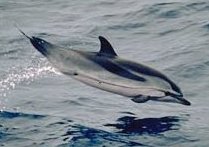Stenella
| Stenella Temporal range:
| |
|---|---|

| |
| Striped dolphin | |
| Scientific classification | |
| Domain: | Eukaryota |
| Kingdom: | Animalia |
| Phylum: | Chordata |
| Class: | Mammalia |
| Order: | Artiodactyla |
| Infraorder: | Cetacea |
| Family: | Delphinidae |
| Subfamily: | Delphininae |
| Genus: | Stenella Gray, 1866 |
| Type species | |
| Steno attenuatus [1] Gray, 1846
| |
| Species | |
|
S. attenuata | |
Stenella is a genus of marine mammals in Delphinidae, the family informally known as the oceanic dolphins.[2][3][4]
Species
[edit]Currently, five species are recognised in this genus:[3]
| Image | Common Name | Scientific name | Distribution |
|---|---|---|---|
 |
Pantropical spotted dolphin | S. attenuata | eastern Pacific Ocean |
 |
Atlantic spotted dolphin | S. frontalis | tropical areas of the Atlantic Ocean |
 |
Spinner dolphin | S. longirostris | Pacific Ocean |
 |
Clymene dolphin | S. clymene | Atlantic Ocean |
 |
Striped dolphin | S. coeruleoalba | North and South Atlantic Oceans, including the Mediterranean |
S. rayi was a species of this genus found in North Carolina, in the early Pliocene.[5]
The common name for species in this genus is the "spotted dolphins" or the "bridled dolphins".[2][3] They are found in temperate and tropical seas all around the world.[2][3] Individuals of several species begin their lives spotless and become steadily more covered in darker spots as they get older.[2][3]
The genus name comes from the Greek stenos meaning narrow.[2][3] It was coined by John Gray in 1866 when he intended it as a subgenus of Steno.[2] Modern taxonomists recognise two genera.[2][3]
The clymene dolphin (S. clymene) is the only confirmed case of hybrid speciation in marine mammals, descending from the spinner dolphin (S. longirostris) and the striped dolphin (S. coeruleoalba).[6]
Stenella dolphins tend to be more active during nighttime and spend their daytime resting. Although these dolphins are supposed to spend 60% of their daytime resting, they happen to be exposed to human activities for 80% of their day. These patterns of sleep deprivation can have negative impact on their resting habit and leads to decline in their population size.[7]
References
[edit]- ^ Wilson, D. E.; Reeder, D. M., eds. (2005). Mammal Species of the World: A Taxonomic and Geographic Reference (3rd ed.). Johns Hopkins University Press. ISBN 978-0-8018-8221-0. OCLC 62265494.
- ^ a b c d e f g Tinker, Spencer Wilkie (1988). Whales of the World. Brill Archive. p. 310. ISBN 9780935848472.
- ^ a b c d e f g Klinowska, Margaret; Justin Cooke (1991). Dolphins, Porpoises and Whales of the World. IUCN. p. 429. ISBN 9782880329365.
- ^ Walker, Ernest Pillsbury; Ronald M. Nowak; John E. Heyning; Randall R. Reeves; Brent S. Stewart; John E. Heyning; Randall R. Reeves; Brent S. Stewart (2003). Walker's Marine Mammals of the World. JHU Press. p. 264. ISBN 9780801873430.
- ^ Bianucci, Giovanni (May 2013). "Septidelphis morii, n. gen. et sp., from the Pliocene of Italy: new evidence of the explosive radiation of true dolphins (Odontoceti, Delphinidae)". Journal of Vertebrate Paleontology. 33 (3): 722–740. Bibcode:2013JVPal..33..722B. doi:10.1080/02724634.2013.744757. ISSN 0272-4634.
- ^ Amaral, Ana R.; Lovewell, Gretchen; Coelho, Maria M.; Amato, George; Rosenbaum, Howard C. (2014). "Hybrid Speciation in a Marine Mammal: The Clymene Dolphin (Stenella clymene)". PLOS ONE. 9 (1): e83645. Bibcode:2014PLoSO...983645A. doi:10.1371/journal.pone.0083645. PMC 3885441. PMID 24421898.
- ^ Tyne, Julian A.; Christiansen, Fredrik; Heenehan, Heather L.; Johnston, David W.; Bejder, Lars (2018). "Chronic exposure of Hawaii Island spinner dolphins (Stenella longirostris) to human activities". Royal Society Open Science. 5 (10): 171506. doi:10.1098/rsos.171506. ISSN 2054-5703. PMC 6227997. PMID 30473795.
Lua error in Module:Navbox_with_collapsible_groups at line 6: attempt to call field 'with collapsible groups' (a nil value). Lua error in Module:Navbox_with_collapsible_groups at line 6: attempt to call field 'with collapsible groups' (a nil value).
